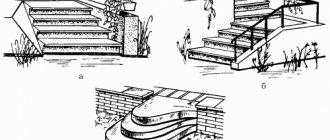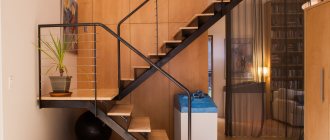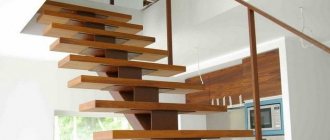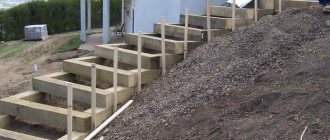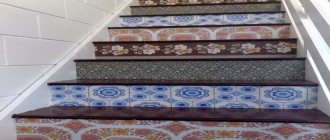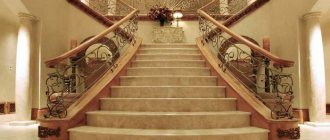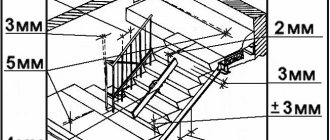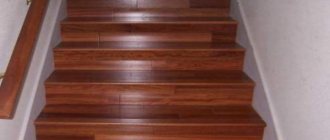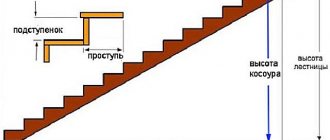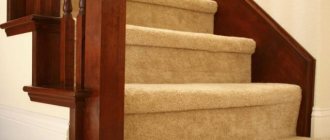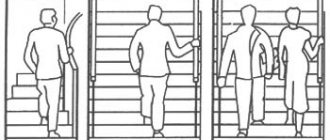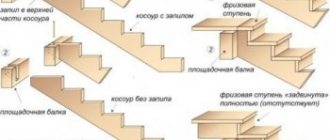This term has other meanings, see Staircase (meanings).
Chkalov Staircase in Nizhny Novgorod Potemkin Staircase in Odessa Staircase in the Mariinsky Theater on pendants with a diameter of 52 mm Bramante Staircase in the Vatican Museum Metal spiral staircase Spiral staircase tower in Palazzo Contarini del Bovolo in Venice The world's longest staircase in the Niesenbahn funicular in Switzerland has 11,674 steps Spiral staircase without a central pillar. Castle of the Teutonic Order. Bad Mergentheim
Ladder
- a functional and structural element that provides vertical connections. The staircase consists of a number of steps. Typically this term is applied to elements of buildings or structures that are a load-bearing structure. The term is also used to include staircases, lifting elements of service vehicles (for example, fire engines), stairways of ships, airplanes and helicopters, rope ladders, garden stepladders, escalators, etc.
Content
- 1. History
- 2 Classification 2.1 By purpose
- 2.2 By location
- 2.3 By material of manufacture 2.3.1 By main load-bearing elements
- 2.3.2 by the presence (absence) of a riser
- 2.3.3 By the number and configuration of flights within one floor
- 2.4.1 According to the shape of the steps
- 3.1 Steps
- 4.1 Symbolism
History[ | ]
The first stairs appeared during the first human settlements. Primitive people adopted the experience of animals, climbing uphill along the so-called goat paths
, reminiscent of a gnarled staircase.
In 2004, in Hallstadt, Austria, scientists discovered a perfectly preserved wooden staircase in an ancient salt mine. This staircase is the oldest known to date. Only 6 m of steps have been excavated. The salt allowed the wooden elements of the staircase to be perfectly preserved. Scientists claim that it was built 5000 BC. e.
The first written evidence of the technology of constructing stairs was in Egyptian papyri - 1st millennium BC. e. Egyptian pyramids are giant staircases that reach into the sky.
The Mayan staircases were covered with hieroglyphs and were the most important part of the pyramids.
It was a tradition in Assyrian architecture to build on an elevated surface. In the palace of Darius, built in 521 BC. e.? the walls of the staircase leading to the large apadana were decorated with reliefs depicting warriors, lions, bulls, and a procession of prisoners bearing gifts.
The ancient Greeks and Romans, who built colosseums, amphitheaters and temples, could not do without massive staircase structures. Ancient temples were built on raised platforms (stylobates), consisting of a series of steps. Sometimes the steps reached more than 2 m in height.
In the Middle Ages, castles had defensive walls and towers, which were climbed by stairs, and dark, damp basements and dungeons, into which they were descended by stairs. Special staircase guilds were created, which passed on the secrets of staircase construction from generation to generation; the construction of spiral staircases required special mathematical calculations. Spiral staircases in the towers of medieval castles were built in such a way that they were climbed clockwise. This was done so that, in the case of defending the castle, the attacker would climb the stairs with his left hand forward, which creates difficulties when using edged weapons, giving the tower defender an advantage, since the most powerful blow with the right hand can only be delivered from right to left, which was inaccessible to the attackers . In addition, if the attacker uses a shield to protect himself, he will not be able to use weapons[1].
In Gothic France, special attention was paid to stairwells, which were often made to protrude from the facade and form the main entrance to the building.
During the Renaissance, classicism, baroque, rococo, and art nouveau, staircases acquired the imprint of the era, bent, twisted, and were decorated with sculpture, columns, and forged railings.
Sir Henry Wotton, an English poet, architect and diplomat, wrote in 1624: “To make a good staircase is a difficult architectural task.” He recommends that the stairs be well lit so that no one can accidentally fall or trip, leave enough space above the head “so that the person climbing has enough air,” and emphasizes the importance of wide steps and a slight slope, “since our legs get more tired when going up than when going down.” "
With the development of methods of processing materials and the development of new ones, the appearance and decoration of stairs changed.
Interesting combinations of materials
We have already talked in previous articles about a variety of staircase structures - completely metal (fire escapes), wooden (to the second floor), reinforced concrete (entrance lobbies). We also talked about combined structures. I would like to say something special about them. Complex staircase structures have their own charm; they contain dynamics and life. For example, stone steps go well with iron fences. Tile and glass, wood and forging - such combinations have already become classics in the architecture of stairs. Of course, the imposing marble staircase with a luxurious wide flight and figured balusters evokes admiration. But the rapid design with porcelain stoneware steps and stainless steel railings is also good. Properly selected staircase elements will create a harmonious structure that will fit perfectly into the existing interior and complement it with its perfection.
In conclusion, watch a video about the types of stairs and how to choose the right components of this familiar, but so different design. Share your thoughts with us and engage in dialogue!
Source
- Author: AlikaAl
Share with your friends!
Classification[ | ]
There are different classifications of stairs.
By purpose[ | ]
- Basic – designed for evacuation of people and general use
- Auxiliary: emergency ladders - provided for emergency rescue operations
- service stairs - intended for entering the basement or attic
- roofing ladders – designed for safe maintenance of the roof and its elements
By location[ | ]
- internal stairs placed on stairwells;
- internal open stairs;
- external open stairs[2]
- In-apartment
According to the material of manufacture[ | ]
Goat trail
- Wooden (most often oak, pine, beech, cedar, larch, ash) - in-apartment, low-rise residential buildings, etc.
- Concrete - main stairs of civil and industrial buildings
- Reinforced concrete
- Brick
- Made from natural stones
- Made from mineral materials (porcelain stoneware, tiles, etc.)
- Metal (stainless steel, aluminum alloys, cast iron, copper, etc.) - fire, emergency, technical
- Forged
- Rope
- From glass. For the manufacture of such stairs, triplex is used (three layers of glass are glued with a special polymer film, which ensures absolute safety of the glass when broken)
- Made of plastic
- Combined stairs (stairs in the design of which combinations of different materials are used: metal-glass; wood-metal; metal-stone, etc.)
The use of this or that material depends on the functional purpose of the staircase, as well as on the conditions of its operation.
According to the main load-bearing elements[ | ]
- On the stringers
- On the bowstrings
- On rails - the steps are connected to each other by special spacers - rails, which, together with the steps and the handrail, form a supporting structure
- Suspended cable
- Without bowstrings - steps and risers are attached directly to the wall
- Cantilever - one side of the steps is fixed to the wall, and the other is free
by the presence (absence) of a riser[ | ]
- open (without riser)
- closed (with riser)
- semi-closed (with a half-riser partially covering the gap)
By the number and configuration of marches within one floor[ | ]
- With straight marches One-, two-, three-, four-march
- With crossing marches
- Pyramid
- L-shaped
The main names of stairs, according to their plan geometry[ | ]
- a) single-flight straight staircase: b) with the top step raised a quarter
- c) with a quarter landing at the top step
- d) with the input stage turned up by a quarter
- e) with a quarter platform at the entrance step
- f) with a quarter-raised entrance and upper stage
- g) with two quarter platforms
- l) double-flight arched with half platform
- m) two-flight corner staircase with a quarter landing
- n) three-flight arched S-shaped staircase with two quarter-platforms
- o and p) three-flight T-shaped staircase with quarter landing
- q) three-flight arched with two quarter platforms
- r and s) three-flight E-shaped staircase with half landing
- t) single-flight circular
- single-flight spiral staircase u) with a massive stand
- v) with shaft
- Y-shaped staircase: y) single-flight at the entrance and double-flight at the exit
- z) two-flight at the entrance and one-flight at the exit
- δ) positive
- φ) positive
- η) positive
According to the shape of the steps[ | ]
- With straight steps
- With winder steps, spiral steps
- corner turning steps
According to the construction method[ | ]
- Prefabricated Large elemental (one-piece flight with interfloor and intermediate platforms)
- Small-element (composed of individual steps, beams, slabs)
- Stairs with visible metal on one central stringer or bowstring (spinal)
- Wood paneled
- on the bowstrings
Various types of folding and compact stairs[ | ]
- swing
- folding. They consist of three, four or more sections, which, in the process of expanding or folding, one after another are superimposed on each other to form a compact structure. Various wooden materials are used in production: oak, beech, maple, pine. Disadvantage: they cannot be adjusted in height and have a large mass.
- staircases that fold like an accordion. They are designed for a height of up to three meters. Accordion stairs are made only of metal (steel, aluminum).
- retractable
- sliding
- attached
Firefighters[ | ]
- External fire escapes,
. Designed to ensure fire extinguishing and emergency rescue operations, they are divided into: P1 - vertical ladders; P1-1 - without fencing (height up to 6 m) - P1-2 - with fencing (height more than 6 m)
- MN - for flights of stairs
- F - solid corrugated steel
Classification of staircases according to smoke resistance[ | ]
Open transitions from the floor through the smoke-free external air zone to the staircases of the smoke-free staircase type H1
Main article: Smoke removal
Staircases, depending on the degree of their protection from smoke in case of fire, are divided into the following types:
- ordinary staircases L1 - staircases with natural light through glazed or open openings in the external walls on each floor
- L2 - staircases with natural light through glazed or open openings in the roof
- H1 - staircases with entrance to the staircase from the floor through a smoke-free external air zone via open passages
Some special cases of staircase designs[ | ]
- Attachment
- used for access to the attic, for harvesting in the garden, during repair work, etc. Simple ones include portable ladders, stepladders, stationary ladders, folding and retractable ladders. They are made of wood, lightweight aluminum profiles or pipes (less often from steel structures). Installed at a large angle (60-75°). - Stepladders
. They are used to get from the top floor to the attic. They can be folding or stationary. The width of such a ladder is about 60 cm. They are made of profiled metal and rods with a diameter of approximately 16 mm. - The assembly ladder
is simplified and does not have guards for workers allowed to work at height (spinners) or for welding. - Landing ladder
(Crane) - a ladder designed for access to the crane. Tilt angle up to 60°
Cascade in the garden named after. Shevchenko, Kharkov
- Landscape staircase
. Serves to provide ascents to multi-level terraces and descents to courtyards. Embedded - in an earthen slope; - Free - the support is a special base. A wide variety of materials are used - wood, concrete, brick, paving slabs, natural and artificial stone.
- a special staircase for boarding and disembarking people from the ship, as well as for their movement between decks
- internal, for communication between rooms inside the ship;
is a ladder made of metal U-shaped brackets. Installed on masts, shafts, towers, chimneys, etc.
is a type of rope ladder used to climb onto a ship.
- An assault ladder
is a fire manual ladder designed to lift firefighters to the floors of buildings through window openings and ceilings. It is part of the fire-technical equipment of a fire truck. It is used in fire and rescue units and civil defense units to fight fires and perform rescue work at heights, to climb to the floors of buildings through windows.
is a metal fire escape designed to climb to the height of a ladder, knock down doors and windows, and remove plaster from walls and ceilings. Can be used as a stretcher for carrying out victims.
- a retractable ladder for climbing to a height of up to 10 meters (up to the 3rd floor). Included in the duty sheet for fire tankers, pump-hose vehicles and first aid vehicles.
Staircase as a structural element of the house
Classification of stairs by purpose by type
Stairs can be classified according to several criteria. According to the angle of inclination, stairs are divided into: main, compact and steep (additional, stepladders and ladders). The main ones have an inclination angle of less than 45°, the compact ones - 60°-45°, and the steep ones - 60°-90°. According to their purpose, stairs are interfloor and special (not main, as well as attic, fire, attic, stepladders). Interfloor staircases are the most important, they serve for communication between floors of a building and are used much more often than special ones. For interfloor stairs, the angle of inclination is usually 30°-40°, for special ones - 45° or more. Depending on the intensity of use, stairs can be main or auxiliary. According to the method of functioning, they are divided into stationary, transformable, and attached. According to the method of attaching the steps to the base: on stringers and bowstrings, on rails (without stringers, cantilever, hanging), on a support column, monolithic. According to their design, staircases are divided into: straight, with a turn of flights, curved (consisting only of winder steps): marching, screw, spiral, modular (both marching and screw can be modular), chain, butterfly. Based on the material, stairs are divided into concrete, reinforced concrete, stone, wood, steel, ceramic, glass and combined (combining several materials).
Requirements for staircase design
When designing or choosing a staircase, you should consider:
- place of the staircase on the plan and layout properties;
- age and number of residents of the house, their health status;
- intensity of operation;
- the likelihood of having to carry large items up stairs;
- The slope angle of the stairs along the entire length must be constant and no more than 42°.
- the width of the flight of stairs for a single-family house should not be less than 0.8 m;
- the permissible design load on the steps of the stairs must be at least 200 kg/m3, and on the railing - at least 100 kg/m3;
- the height of the railing must be at least 0.8 m;
- the clear distance between the balusters is no more than 0.15 m;
- the distance between the flight of stairs and the wall should not exceed 5-6 cm.
Material for the construction of stairs
Reinforced concrete and concrete stairs are mainly installed in residential multi-storey buildings. They are, as a rule, manufactured at the factory and delivered to the site in the form of large blocks - with enlarged flights and large-panel platform slabs. The flight slab is laid on the mortar, and the flights of stairs and slabs themselves are fastened by welding. The advantage of such a ladder is its durability and ability to withstand high loads. The downside is the apparent bulkiness. Wooden stairs are made from both soft wood (pine, spruce, larch) and hard wood (oak, beech, maple, ash, cedar). Load-bearing structures usually do not combine different types of wood, but use exotic materials in finishing, for example, teak, cherry, cypress, and mahogany. To ensure a harmonious combination of wooden stairs with furniture, windows, doors and parquet, tinting and varnishes are used.
The advantage of wooden stairs is ample design possibilities and a presentable appearance. The downside is a fire hazard and the need for regular maintenance. Metal stairs in a house usually play a supporting role. Moreover, they are located both in the building itself, for example, screw ones, and on its facade, for example, fire escapes. They are made of steel. The advantage of metal stairs is the reliability and elegance of the design, especially if it is made by forging. The downside is that the steps are slippery, resulting in a high risk of falling. To avoid this, anti-slip mats are usually placed on slippery steps. Stairs made of natural stone are very appropriate in executive buildings and luxury apartments. When working with stone, a sense of proportion is important, since its main disadvantage is its bulkiness. Therefore, steps and frames, handrails, etc. are usually made of stone. - from other materials. The second disadvantage is that it is easy to slip on stone steps (as is the case with metal, as well as ceramic and glass), because stone steps are polished. The advantage of a stone staircase is strength, resistance to chemical influences and abrasion, reliability and durability. Ceramics are one of the possible solutions for those who want to decorate floors and staircases in the same style. Plus - resistance to chemical attack and abrasion. The downside is fragility (if there is a very strong impact, the tile may crack). The second disadvantage is the likelihood of slipping (if the ceramics do not have a rough surface). Glass is the most unconventional, but very effective and, perhaps, even avant-garde material for stairs. Typically, shockproof or reinforced glass is used, combining it with other materials. The advantage of a glass staircase design is aesthetics and grace. The downside is fragility and slippery steps.
Staircase design types
The staircase consists of a base and steps. The basis is load-bearing beams (stringers, bowstrings, bolts) or a support column. The stringers are located under the steps, and the strings are located on the sides (ends) of the steps. The bolt is mounted into the wall and connects the steps to each other. The steps are open or with risers. Depending on the shape, they are straight, straight beveled, winder and arched. Their number in a flight must be no less than three and no more than 18. The design of the staircase also includes landings and flights. The march connects the two landings and rests on them. Railings, balusters, sculpture, as well as built-in lighting are among the additional and decorative elements of the staircase structure. The width of flights of stairs and landings must be at least 1 m (0.8 m is allowed). Between the door and the stairs it is necessary to equip a platform with a minimum width corresponding to the width of the door. The maximum riser and tread heights for interior stairs are 17 and 29 cm, respectively. An increase in the height of a step by 1 mm requires a decrease in its width by 2 mm. The height of the steps of circular and spiral staircases usually ranges from 18 to 20 cm, their width ranges from 50 to 100 cm. The depth of the steps of a spiral staircase at a distance of 15 cm from the supporting column should be at least 10 cm. Cutting the edges of the steps tangentially increases their width. The last step in height should coincide with the floor level.
Species features
Marching stairs are the most common in design. They are based on one or two wooden or steel stringers. Although they can be not only on stringers, but, for example, on bolts, modular. Combinations are possible: a metal stringer and wooden steps, or a wooden stringer and glass steps, etc. Flight stairs can consist of one or more flights connected by platforms. If the staircase provides intermediate platforms and a passage under them, then the distance from the floor to the bottom of the landing structure must be at least 2.1 m. The rotation to the landing can be 90° or 180°, but another angle is possible if the layout of the room requires it . Instead of a turntable, a turn with a fan arrangement of feet can be arranged, which allows you not only to change direction, but also to simultaneously gain lifting height. When turning 90°, three winder stages are most optimal. A spiral staircase is one continuous turn around a central axis or column, to which, most often, the steps are attached (all winders). The column carries its own weight of the stair steps and operational loads, and sometimes also serves as a support for the floor span above the stairs. There may be an option with a load-bearing central post and a spiral bowstring. Such stairs take up minimal space.
Spiral staircases are a type of spiral staircase with two load-bearing spiral strings. Modular (chain, spine) stairs. They are based on a metal or wooden “vertebra” module with a step fixed on it. Each module has a device for coupling with the upper and lower similar modules, and the coupling into a single stringer beam is carried out hingedly, at different angles, as a result of which the staircase takes a given shape. Their typology is very diverse: these are straight and turning stairs, with platforms and rounded ones, spiral and curving ones. The butterfly ladder or “duck (goose) step” is an extremely compact design with a slope of over 45° for occasional use.
Calculation
The calculation of the staircase structure is based on determining the main dimensions of the flight of stairs, which will best suit the convenience and safety of movement. For comfortable lifting, at each step a certain ratio must be maintained between the distance a person moves forward and the distance he rises. The patterns of the optimal ratio of the sizes of treads and risers used in the calculation of stairs have been established: a formula based on the step length, a convenience formula and a safety formula. When designing, you must adhere to the rule that all steps within one flight must be the same size in height and width. The width of the tread and the height of the riser should be constant values. Their size is determined based on the following principles - the double height of the riser (b) and the width of the tread (a) should be equal to the average human step: 2b + a = 60-66 cm. This formula is called the “Step Formula”. In this case, two more regularities should be taken into account: the most
Stairs with a tread to riser ratio of a - b = 12 cm (convenience formula) are convenient, and stairs with a ratio of a + b = 46 cm (safety formula) are the safest. The ratio of the tread and riser determines the slope of the march, which follows from the properties of similar triangles. When choosing it, you need to ensure that the vertical distance from the top plane of any step of the staircase to the ceiling is at least 2 m. The slope of the staircase is determined by the ratio of the height to the length of the horizontal position (projection) of the staircase on the plan, and is an important value for calculating the parameters of the staircase, since determines the ease of movement along it and its steepness. For convenience, the slope should not exceed 40°-45°. A greater slope will lead to the fact that you will have to go down the stairs backwards, which is very inconvenient and dangerous. If it is expected that several people will move along the stairs at the same time, its width should be appropriate. At the design stage, it should be taken into account that the staircase is a heavy structure. Therefore, when choosing a location for the staircase, remember that it will most likely have to be strengthened or an additional support structure created. The heaviest load is created by a spiral staircase. Although it has a big advantage - it allows you to save space in the house.
Ladder dictionary
The staircase consists of two main elements: the base (stringer, bowstring, bolts or support pillar) and steps (open or with risers). Its additional elements include platforms between flights, railings, decorative sculptural elements, balusters, and built-in lighting. Operating with a set of special staircase concepts and terms will allow you to better understand its design features. Balusters are decorative parts of the fence located between the steps and railings, and “support” the railings. Balustrade is a set of fencing for a flight of stairs with adjacent landings, consisting of balusters, handrails and intermediate posts. The bolt is a steel element that connects the steps to each other. The height of the step (riser) is the vertical element of the step; closing the gap between adjacent treads, giving the stairs additional rigidity and serving as additional support for the tread. Steps without risers are called closed, while steps with risers are called open.
The length (lay) of a flight of stairs is the distance from the front edge of the lower frieze step to the leading edge of the upper frieze step, measured horizontally along the midline of the flight of stairs. A winder step is a step whose inner side is narrower than the outer one. Used when turning a flight of stairs. Stringer is an inclined load-bearing beam on which the steps of a flight of stairs rest on top.
A flight of stairs is an inclined part of a staircase - a structure of a number of steps that connects platforms or floors. The number of steps in a march must be no less than three and no more than eighteen. The supporting pillar is the central pillar around which the steps of the spiral staircase twist. The support post is the main element of the fence, bearing the entire load along with the handrail. The staircase base is the structure that holds the staircase in a stationary position. Railings are safety fencing for staircases and landings. The useful width of a flight of stairs is the distance between the surface of the wall (plastered, tiled) or the central post (for a spiral staircase) and the inner surface of the handrail, or the distance between the inner surfaces of two handrails of the staircase. Measured at the height of the finished staircase handrails.
Handrail is a structural element installed on the railing, wall or rack of a spiral staircase. The gap (gap) between the stairs and the wall is the clear distance from the flight of stairs or landing to the surface of the wall or adjacent structural elements. An intermediate landing is a landing located between floors. Tread is a horizontal element of a step. For ease of walking, it should be no less than the length of a person’s foot. The size of the protrusion is the horizontal distance by which the front edge of one step protrudes (overhangs) above the tread of another, located below the step, that is, the difference between the actual and calculated width of the tread. The clear distance between steps is between the top surface of one step and the bottom surface of the tread of another, located above. The middle line is the line of the most convenient movement along the stairs.
The post of the spiral staircase is the central rod. A step is a part of a staircase that is stepped on when ascending/descending. Depending on the shape, there are straight, straight, beveled, winder, and arched. A string is a side part of a staircase, a beam or board to which the steps are attached. Slope is the ratio of the height of the riser to the width of the tread, which allows you to judge the steepness of the stairs. The step of a staircase is the height of one step, including its thickness. The width of a step (tread) is a calculated value, the horizontal distance (along the midline of a flight of stairs) from the leading edge of one step to the leading edge of the next step.
We decide on material and design
The decision about what kind of staircase will be must be made at the design stage of the house in order to competently organize the planning space, determine the size and location of openings in the ceilings according to the type of staircase that will be chosen, and also provide for its fastening methods. Please note: stairs should only be attached to strong load-bearing structures (made of concrete, thick timber, brick at least 25 cm thick), but in no case to thin non-load-bearing walls, for example, plasterboard partitions. It is most convenient to place the internal staircase for a cottage in the center of the house. This option does not limit the access of natural light to the rooms located along the perimeter of the external walls, and the descent/ascent to them is quite convenient. If the staircase is located along the outer wall, then it will take up space where a room with a window could be located and, as a result, loss of living space. Since stairs take up a lot of space, one of the architect’s tasks is to offer not only a practical and beautiful, but also a compact option. For example, this could be a staircase with a turn, without an intermediate resting area, but with several winder steps. Or spiral and fan staircases. These structures also do not take up much space and can be placed against a wall or in the middle of the room. They are inexpensive and beautiful, but it is better to entrust their installation to qualified specialists. Today, the domestic market offers a wide range of materials and technologies, which allows you to buy (or build) a staircase suitable for any interior.
Author: Efrosinia Umeltseva Source: DOM.ua
Structural elements[ | ]
Any staircase consists of inclined flights and horizontal turning platforms, landings (floor and intermediate). The steps of one flight can rest on inclined slabs (slab flight) or on inclined beams - ribs (ribbed flight). The ribs are located under the steps (kosour), or the steps cut into the side surface of the beams (string). The staircase on rails can be called relatively new. The steps on the outside of the staircase are connected to self-supporting handrails, railings, to the crossbar on the ceiling, to the base with metal bolts, rods and supports, and on the inside they are attached to the wall. These ladders are universal in use and easy to assemble and install.
Steps[ | ]
Main article: Stage (architecture)
Stair string[ | ]
March[ | ]
The width of a flight of stairs for main staircases in buildings is usually 90–135 cm, depending on the classification of the building and the purpose of the staircase. The number of steps in one flight should not exceed 18. After 18 steps, a platform should be provided (with the exception of spiral staircases).
In construction, reinforced concrete staircases are divided into:
- flat without frieze steps. Symbol - LM;
- ribbed with frieze steps. Symbol - LMF;
- ribbed with half platforms. Symbol: LMP. They come with two half-platforms or without a lower one.
Railing[ | ]
Main article: Railing
The main task of the railing is to ensure the safety of movement on the stairs. Standard fencing consists of a handrail
and vertical supporting
balusters
. The space between them is filled according to the requirements of the interior. These can be: parallel threads, vertical posts, glass screens or screens made of perforated steel, carved wood, as well as hand forging, or forging from standard stamped elements. There are two ways to attach the railing to the stairs: directly to the step or to the end of the step using special fasteners.
The height of the railing depends on the purpose of the staircase and ranges from 86 to 110 cm.
Handrail[ | ]
An element installed on the railing, on the wall. A wall handrail is used in cases where the flight of stairs is limited on both sides by walls and it makes no sense to install racks. Handrails installed in residential buildings are usually made of plasticized PVC. Such a handrail is difficult to damage, which allows it to maintain a presentable appearance for a long time.
Baluster[ | ]
The lower and upper support posts of the railing, having a round shape in diameter. They are made by turning or concreting and casting into a mold.
The minimum parameters of stairs, their dimensions, configuration, material for different types of buildings and structures are regulated in regulatory documents. (SNiPs and GOSTs for Russia, DBNs and DSTUs for Ukraine).
External stairs
When designing an external staircase, the same building codes are used as when designing internal stairs. The peculiarity and main difference between entrance stairs and internal ones is that these stairs exist in more severe climatic conditions. Being outdoors, they are exposed to large changes in humidity, daily and annual temperatures, solar radiation, and precipitation in the form of snow and rain. In addition, entrance stairs are most often made as a separate structural element not connected to the building. Due to the difference in weight, as well as as a result of the forces of frost heaving of the soil, the settlement values of the building and the stairs vary greatly. This can lead to warping and destruction of the stairs. Typically, settlement of a building occurs during its construction, then stabilization occurs; further movements of the foundation can occur due to erosion of the foundation soil, nearby construction work, or the passage of heavy vehicles. Movements of the building due to the forces of frost heaving of the soil are not allowed; the foundation must be buried below the depth of soil freezing. The foundation for large and heavy concrete stairs must be made to the same depth as the foundation for the building.
To reduce the negative consequences of the influence of the external environment, the external staircase should be located under a roof (canopy or canopy) and made of moisture-resistant materials - antiseptic wood, concrete, stone or brick.
Light wooden stairs (Fig. 79) are supported on columnar foundations called “bulls”. These foundations must also be buried to the depth of soil freezing. If the staircase is being built after the construction of the house, then you need to wait until the soil in the foundation cavities settles or make a deep foundation for it, preventing the installation of stairs on the bulk soil of the sinuses. Otherwise, the stairs will sag due to soil compaction.
rice. 79. Options for constructing external wooden stairs
It is convenient to make foundations below the freezing depth of the soil from asbestos-cement, cast iron and thick-walled steel pipes by immersing them in drilled wells. It is also possible to make foundations from bored piles. To prevent foundations from being squeezed out by the tangential forces of frost heaving, it is recommended to wrap the pipes with plastic film and fill the distance between the walls of the pipes and the walls of the drilled well with coarse and medium-grained sand. The bottom of the pipe should be anchored in a concrete pad located below the freezing depth.
In order to reduce the cost of construction, the construction of deep foundations is often neglected. Shallow foundations - “bulls”, are usually made of monolithic concrete, with a depth below the plant layer of the construction site. When using shallow foundations in winter, the stairs will rise from the forces of frost heaving and warp. For country-type houses that are used seasonally, you need to take this point into account and make the entrance door to the house with a threshold, otherwise, when opening, it may catch the bottom of the raised landing and jam. Or make the landing on cantilever beams protruding from the wall, and rest the bottom of the stairs on shallow “bulls”. In this case, at the junction of the march to the site, something like a hinge is obtained. The frozen soil squeezes out the “bulls” and the bottom of the flight of stairs, and the platform, made on consoles, remains motionless. In construction regions with non-heaving soils, all these tricks, of course, are not needed. Shallow staircase foundations mean the staircases warp every year.
In the upper part of the foundations, embedded parts are provided for fastening the lower part of the stairs. The design of the fasteners for the lower part of the stairs can be very diverse, the main condition is that it must ensure the immobility of the stairs. Wooden staircase elements in contact with the concrete foundation or embedded in the body of a brick wall should be separated from them by a layer of rolled waterproofing. The wood of the stairs must be treated with antiseptic compounds. In addition to this, it is recommended that external stairs be completely painted with waterproof paints.
Otherwise, the designs of external wooden stairs are not much different from the designs of internal stairs. They are made on support beams located under the steps - stringers or on the side of them - bowstrings.
The easiest to make is a small, three-four-step staircase on bowstrings. This is a very common design in the practice of country house construction, designed, as a rule, for temporary use until the construction of a permanent staircase. An external staircase on strings is made without risers; its manufacture requires two long boards for strings and three or four for treads. The connection of the treads with the bowstrings is made using wooden blocks, which are attached to the inside of the bowstring.
Staircases with stringers are more difficult to manufacture. Stringers are made from two boards with cutouts for treads and risers, but for external stairs you can do it simpler: sew grooves onto the stringers and thereby create the required profile (Fig. 80). With the help of hammers you can create not only a stringer, but also a side lining of the stairs, extending them to the support post of the landing. In order to use boards of any available thickness under the steps, not two, three, four or even five stringers are installed. The tread will not bend, even if it is made of 20 mm thick boards. Additional stringers can also be added to the staircase along the strings, placing them under the steps between the strings.
rice. 80. Design options for external wooden stairs
If necessary, inclined railings with a height of at least 900 mm are made on one or both sides of the stairs. For stairs with one or two steps, railings are not always required.
Solid external stairs are made of brick, reinforced concrete, and metal. A brick staircase (Fig. 81) is not the most suitable option, but under certain conditions brick can be used in the construction of small stairs. Solid ceramic bricks with a length of 250, a width of 120 and a thickness of 65 mm (single) or 103, sometimes 140 mm (double) are used. Accordingly, the main dimensions of the step elements depend on these indicators: the height of the riser and, to a lesser extent, the width of the tread. The dimensions of the step will be the sum of the dimensions of the brick and the thickness of the mortar layer, which is usually about 10 mm.
rice. 81. External stairs made of brick, monolithic and precast reinforced concrete
Let's consider possible riser height options. It should be in the range of 140–170 mm, with extreme values: 120–200 mm. The smallest riser height for a brick staircase will be 130 mm, this distance is the sum of the width of the brick (120 mm) and one layer of mortar (10 mm). In this case, the brick is installed on an edge. If you lay two bricks one on top of the other, the height of the riser will be 140 mm (the thickness of the two bricks is 65 + 65 = 130 mm plus the thickness of the mortar layer). If the lower brick is installed on a spoon (flat), and the upper one on the edge, then the height of the riser will be 195 mm (65 + 120 + 10 mm). All of the listed riser height options fall within the regulated standards. The second option (140 mm) seems to be optimal both in terms of size and ease of execution. Thus, from the formula characterizing a person’s step, the width of the tread should be 340 mm.
At first glance, the width of the tread, if made from standard brick sizes, does not quite meet the requirements for it. If you make a tread the size of a brick (250 mm), then the step turns out to be too narrow. If you make it one and a half bricks (250 + 120 + 10 = 380 mm), then the width of the tread turns out to be slightly wider than required, which is not very convenient. The way out of this situation is very simple. After laying the two bottom rows (first step), the next two rows (second step) can be slightly shifted relative to the front edge of the first step and thus increase or decrease the width of the tread. In our case, the overlap of the steps on each other is 40 mm. Formula 2a+b = 600...640 mm is satisfied: 2×140+340=620 mm - the stairs are comfortable for walking.
A brick staircase must be built on a concrete foundation. In this case, it is impractical to make a solid foundation to the entire freezing depth; it is replaced with a reinforced concrete slab. The plant layer is removed and a compacted sand preparation up to 100 mm thick is made. Then the formwork from the boards is installed. The slab is reinforced according to calculations; if there is no one to do the calculations, then the slab can be reinforced with a margin of safety, for example, laying a reinforcing mesh with cells 150×150 mm from reinforcement with a diameter of at least 12 mm. The slab is poured in one step with M200 concrete. After three days, the slab can be stripped and loaded with the staircase under construction.
The first step and end walls are laid out of brick, the space formed by the step and walls is filled with small crushed stone. The second step is laid out over the compacted crushed stone and the first step, and the middle of the future staircase is again covered with crushed stone and compacted. This is how the entire staircase is built step by step.
The main disadvantage of a brick staircase is that the cement-sand screed or facing tiles do not adhere well to the brick tread. This is due to water getting under the tiles and the latter rebounding in the winter, and the screed simply crumbles and peels off from the brick due to its small thickness. If you leave the brick uncovered, it will also bounce off over time, since it is very difficult to protect the masonry seams from water getting into them. One way out of this impasse is to frame the steps with a corner. This solution does not add aesthetics to the stairs, but it prevents the brick from chipping, and the cement-sand screed laid on top of the steps holds up better. The corner is subsequently “hidden” under a cement-sand screed and facing the steps with tiles or stone.
However, it is not at all necessary to build the staircase entirely from bricks. It is quite acceptable to lay out brick end walls, and fill the space between them with fine crushed stone and make steps from monolithic reinforced concrete, or pour a monolithic reinforced concrete ramp and lay reinforced concrete steps on it. The brick walls of the staircase are laid out on a strip foundation made below the freezing depth. It is better to begin the construction of such a staircase after the main building has settled, then it can be quite accurately brought to the doorways. In any case, the staircase should be separated from the walls of the house by an expansion joint and made slightly lower than necessary. When the building settles, it will slide along the expansion joint along the stairs and it will not be destroyed.
Water drainage must be provided from all steps of external stairs, regardless of whether there is a canopy over the stairs or not. With a small staircase and a small number of steps, it is permissible to lay the steps with a slight slope from the building. You can also drain water through special trays, which are installed along the junction of the tread with the riser and near the side railings of the stairs. Such trays are made in the form of open recesses in the steps.
The fencing of external stairs is usually made in the form of a solid solid brick wall or in the form of a lattice metal railing or balustrade. The staircase can be equipped with railings made of metal elements. In this case, you should first consider the method of attaching them to the brickwork or foundation.
One of the main requirements for stairs is safety of movement on them. This can be achieved by covering the treads with ceramic tiles with a rough or grooved surface. And under no circumstances should you use glazed tiles. Instead of tiles, you can use slabs of rough wild stone.
Stairs in culture and art[ | ]
The Book of Genesis describes Jacob's ladder, standing on the earth and touching the top of heaven. The image of a ladder to heaven was interpreted in the works of John Climacus (see Ladder), and a special type of Orthodox rosary is associated with it - the ladder. In recent history, the rock band Led Zeppelin turned to the image of a stairway to heaven (see “Stairway to Heaven”).
- Stairs forming "impossible" figures based on optical illusions were repeatedly depicted in the works of Maurice Cornelis Escher
- The episode of the execution of the rebels on the Potemkin Stairs in Odessa from Sergei Eisenstein’s film “Battleship Potemkin” is considered a classic of world cinema.
- Oleg Menshikov’s hero, Volodya, is trying to find a way out of an enchanted house with an endless staircase in the film “The Staircase”.
Symbolism[ | ]
Stairs are used both as a symbol and part of a religious ritual, they emphasize the importance of climbing. To create the desired effect, the width and steepness of the stairs are important. The equivalents of the ladder are the golden thread, the axis mundi, the world tree, the world mountain, the rainbow, etc. The ladder crosses three cosmic zones, connecting the world of gods, people and the underworld. The staircase is associated with vertical movement. Often the steps of the ladder define the hierarchy of deities.
The staircase symbolizes:
- transition from one plane of existence to another,
- breakthrough to another ontological level,
- the communication of Earth with Heaven in both directions: the ascent of man and the descent of the deity.
- has the meaning of the world axis, which connects it with the Cosmic Tree and pillar,
- represents access to reality, the absolute, to the transcendent, moving from the unreal to the real, from darkness to light, from death to immortality. This transition is the path to another world through death,
- makes Sky accessible, but can be removed. Originally the ladder existed in paradise, and there was a continuous connection between God and man, but with the Fall it was lost,
- bridge, associated with rituals of passage. Like a bridge, it may have sharp edges. (The stairs of eastern fakirs are shaped like knives),
- hierarchical pyramid, a sign of a successful career (“move up the career ladder”).
- leading upward - courage and boldness; leading down is cowardice and meanness.
The steps represent:
- the incoming power of human consciousness, passing through all stages of existence
- initiation stages. Their number ranges from seven to twelve. During initiation, a person in knowledge and realization descends in valor.
Among the American Indians, the rainbow is a ladder that gives access to another world.
In Buddhism, the Shakyamuni staircase is depicted with the footprint of Buddha on the lower and upper steps. Shakyamuni descends from the Tushita sky to earth along the ladder brought to him by Indra.
In Tibet, a person’s connection with the sky is carried out through a thread, rope or ladder, which could take the form of a column of smoke, a gust of wind or a ray of light. Previously, the bodies of Tibetans dissolved in light and ascended to heaven through mu. But one day a man accidentally cut the mu with a sword, and from then on people began to die, and their bodies remained on the ground.
In Christianity, the ladder is a symbol of the suffering of Christ. In the early Italian Renaissance, Christ climbs the stairs or is already near the cross, and the executioners, who climbed the stairs, nail the hands of the Savior to the crossbars of the cross. On his way to Haran, Jacob dreamed of a ladder that reached to heaven, along which angels scurried up and down. The Benedictine monk Saint Romuald dreamed of a staircase reaching to heaven, up which the monks of his order, dressed all in white, were climbing. Emblem of Saint Alexis. The ladder of John the Climacus has become a symbol of ascent from one virtue to another and the fight against passions. A symbol of the suffering of Saint Benedict.
Among the Egyptians, the staircase is a symbol of Horus and is under the protection of God. She rises above the material world and connects it with Heaven. “I established a ladder to Heaven among the gods”; “May I, Osiris, scribe of Ani, triumphantly share my place with him who is at the top of the ladder”; “I made a journey from earth to heaven, God Shu helped me to stand, the Sun God strengthened me on both sides of the ladder, and the stars that never set guided me to the top of the path and helped me avoid destruction” (“Book of the Dead”). Hathor holds a ladder so that good people can climb to Heaven. Amulets in the shape of stairs have been found in Egyptian burials.
Among the Jews, the ladder is a means of communication between the Lord and man through angels.
In Islam, the ladder seen by Muhammad leads the faithful to the Lord.
For the Japanese, a ladder is an attribute of the thunder god, personifying a means of communication between Heaven and Earth.
In Mithraism, the initiate ascends a seven-step planetary ladder, symbolizing the passage of the soul through the seven heavens. The shaman climbs a ladder or a pole with seven notches to communicate with the spirits. The sanctuaries of the cult of Mithra were located in the dungeons, and in each sanctuary there was a staircase of seven steps along which they ascended to the abode of bliss.
The Siberian peoples imagined the world (shamanic) tree in the form of a ladder, pole or pillar. The Evenki shaman got to the Upper World by climbing a tree ladder. In the shaman's costume, among the attributes necessary for traveling through various worlds, there are small iron ladders.
The two sides of the staircase are the right and left columns, or Trees of Paradise, connected by crossbars. As with any initiation, reaching the top is fraught with danger, and the climber is seized with a double feeling of joy and fear.
Naturalists of the 18th century built a hierarchical picture of the world, defining “a ladder of subordination, significance and primacy in the development of the abilities of creatures.”
Notes[ | ]
- Arsenal: Medieval Castles and Fortresses
- ↑ 12
Technical regulations on fire safety requirements. Article 39. Classification of stairs - GOST R 53254—2009 FIRE EQUIPMENT. EXTERNAL FIXED FIRE FIGHTER STAIRS. ROOF GUARDS. General technical requirements. Test methods - M.: Standartinform, 2009, p. 2
- Technical regulations on fire safety requirements. Article 40. Classification of staircases
